Niveshaay’s View on the Union Budget 2024
July 26, 2024 | Deep Dives
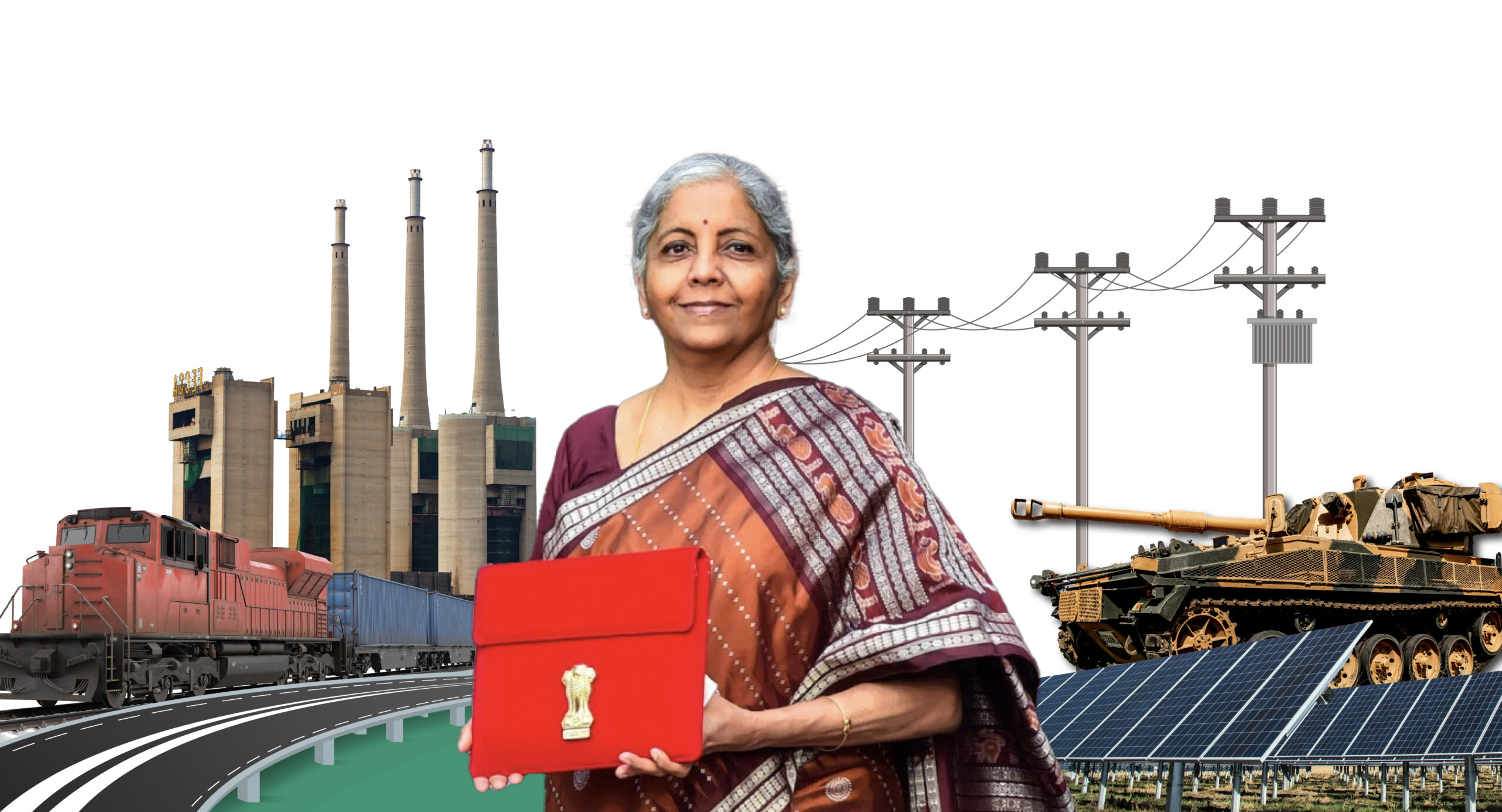
The Union Budget 2024 is themed around the roadmap for the pursuit of ‘Viksit Bharat,’ aiming to generate employment, enhance financial stability, improve credit access, and foster overall economic growth, making it a unique model of self-propelling growth strategy. While tax adjustments are part of the new policies, the focus remains on supporting sustainable corporate growth and economic stability. The government's continued emphasis on enhancing the company’s earning potential reflects a commitment to ensure long-term success and resilience.
Moreover, the budget’s initiatives to stimulate consumption through generating employment in the economy signal a proactive approach to economic health and welfare. To reduce the gap between receipts and expenditure, the government needs to do a balancing act. India’s fiscal deficit for FY24 was ~5.63% of the GDP which the government aims to bring down to 4.9% of the GDP for FY25 and below 4.5% of the GDP by FY26.
The budget announcement has introduced several policies and measures aimed at different segments of society and the economy. While the comprehensive budget addresses various sectors and stakeholders, our focus will be on examining the specific policies and initiatives that directly impact our investment strategies and allocations. Our analysis will assess the budgetary decisions, offering insights into how such changes will guide our approach.

PART A
1. Push for Energy Transition to continue
The government has continuously prioritized sustainable energy over the last two tenures and the current budget also maintains its focus on initiatives for energy storage, solar rooftops, nuclear energy, and aiding small industries in cleaner energy transitions.
Energy storage: This year's budget emphasizes energy solutions, including pumped storage, to tackle the variability and intermittent issues of renewable energy. Multiple tenders are anticipated, boosting opportunities for pumped storage manufacturers, project financiers, and EPC contractors involved in these projects.
Solar: Solar energy is thriving with strong government support, targeting 280 GW by 2030. Currently, ~85 GW has been installed, and we anticipate continued momentum as execution remains a focus. The 'PM Surya Ghar Muft Bijli Yojna' aims to install rooftop solar in 1 crore households, providing 300 free units of electricity monthly, already attracting 1.28 crore registrations and 14 lakh applications. This is expected to boost domestic solar component manufacturers and EPC players, aided by budget measures like a 10% Customs Duty on solar glass (w.e.f October 2024).
Nuclear reactors: The future energy mix will prominently feature cleaner sources like nuclear energy. The government, in collaboration with the private sector, will focus on establishing and advancing nuclear projects, including the R&D of Bharat Small Reactors. Funding for R&D, as announced in the interim budget, will support these initiatives.
Advanced Ultra Super Critical Thermal Power Plants: The development of Advanced Ultra Super Critical (AUSC) thermal power plant technology, which offers higher efficiency, has been completed. A joint venture between NTPC and BHEL will build an 800 MW commercial plant using AUSC technology, with government fiscal support. This is expected to foster indigenous production of high-grade steel and advanced materials, benefiting the economy.
2. Major Infrastructure Developments on the Horizon
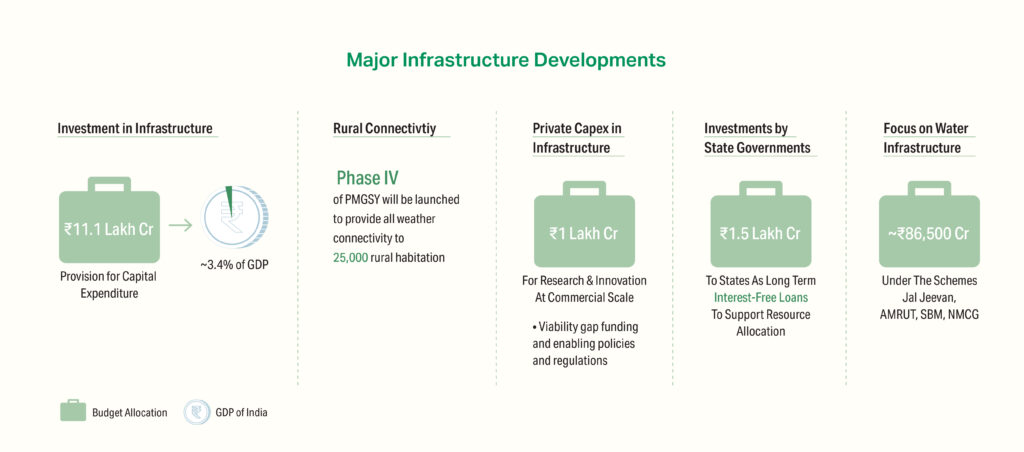
The budget emphasized a comprehensive development initiative called 'Purvodaya', targeting the overall growth of Bihar, Jharkhand, West Bengal, Odisha, and Andhra Pradesh.
Despite previous delays, the government remains steadfast in fulfilling the Andhra Pradesh Reorganization Act's promises, including developing Amaravati as the state capital and completing the Polavaram Irrigation Project. The government's focus and significant expenditure in this sector highlight the potential for local and regional companies involved in infrastructure, particularly those in cement manufacturing and EPC services, to be well-positioned to be major beneficiaries of this development.
Additionally, the government is transforming Bihar with new airports, medical colleges, sports facilities, and the ambitious Patna-Purnea Expressway. These projects, costing ₹ 26,000 crore, aim to reshape the state's transportation landscape.
To further boost infrastructure development in India, the government has decided to partner with State Governments and Multilateral Development Banks to promote water supply, sewage treatment, and solid waste management projects in 100 large cities.
The removal of Basic Customs Duty (BCD) on ferro nickel and blister copper, along with the continuation of a nil BCD on ferrous scrap and nickel cathode for another 2 years, aims to reduce the stainless-steel production cost and is also positive for domestic cell manufacturing.
The government has earmarked ₹11.1 lakh crore, a ~10% increase from the previous year’s allocation, to enhance India’s infrastructure, with a significant focus on rural development, including ₹2.66 lakh crore specifically for rural infrastructure.
With the government’s focus on robust fiscal support for infrastructure, we remain optimistic about sectors like capital goods, equipment manufacturers, EPC contractors, cement companies, metal companies, and other infrastructure-related industries.
3. Manufacturing and services
Railways
The recent budget has unveiled a historic capital expenditure allocation of ₹ 2,52,000 crores, marking a 5% increase compared to the previous year. This strategic investment is aimed at modernizing the infrastructure and enhancing service capabilities like the addition of new lines, Broad-gauge (BG) conversion, High-Speed Rail Corridor, etc. The increased allocation reduces reliance on external sources and borrowing, fostering greater self-sufficiency within the sector. This is expected to significantly benefit companies involved in manufacturing railway components, as well as strengthen the overall safety and efficiency of railway operations.
Defense
The Defense budget has received an allocation of ~₹ 6.22 lakh crore, a tad higher than last year. The ministry is targeting to spend on acquiring new weapon systems for the armed forces, including fighter aircraft, ships, submarines, drones, and specialist vehicles. This increased budget is expected to propel the growth of the Defence companies which may also create a positive ripple effect to companies who provide its products to such defence companies.
Electronics
India had exported just ₹ 12,800 crores of mobile phones in FY2019, which increased 19 times to ₹ 2,40,000 crores in FY2024. With a government outlay of ₹ 6,200 crores PLI scheme for electronics manufacturing and reduced custom duty from 20% to 15% on mobile phones, Printed Circuit Board Assembly (PCBA) of mobile phones, and components such as chargers/adaptors, will strengthen India’s competitiveness globally. This is expected to benefit mobile phone assemblers and electric component manufacturers by giving competitive manufacturing prices.
Textiles
The Budget allocates ₹4,417.09 crore to the textiles sector, up from ₹3,443 crore last year. This includes customs duty cuts and other incentives to drive growth. With current exports of technical textiles at $2.5 billion, India aims to reach $10 billion in five years. Additionally, duties on accessories for manufacturing textile and leather products for export will also be removed which are expected to lower production costs and enhance the competitiveness.
Telecom
The Indian government is actively promoting domestic manufacturing in the telecom sector with an outlay of ₹ 1910.80 crore in the PLI. To further support this, import duties on telecom equipment components (PCBAs) have been increased from 15% to 20%. These changes are designed to incentivize domestic manufacturing and support the cable, tower, and telecom equipment industries, and enhance India's self-reliance in the telecommunications sector.
Pharma
The government's commitment to strengthen the pharmaceutical sector is evident with the increased PLI scheme outlay to ₹ 2,143 crores from the previous outlay of ₹ 1200 crore. This substantial outlay, coupled with committed investments of ₹ 5,000 crores from the industry, will not only support India's drug supply chain but also create new job opportunities and foster innovation in the sector.
Medical Equipment and Medicines
The government has fully exempted three cancer medications from duty and reduced the duty on medical equipment, such as X-ray tubes and flat panel detectors from 15% to 5%. Additionally, all types of polyethylene used in the manufacture of orthopaedic implants are now free from customs duty. These measures will benefit the patients and depict the government’s commitment to social reforms.
4. Agriculture and Allied Industries to benefit
The government prioritizes productivity and resilience in agriculture under Vikshit Bharat, planning to enhance productivity and develop climate-resilient crops through revamped research and competitive funding, including private entities.
Key initiatives include releasing 109 high-yielding crop varieties, promoting natural farming for one crore farmers, achieving self-sufficiency in pulses and oilseeds, developing vegetable production clusters, and establishing a digital infrastructure for agriculture. Financial support for shrimp production and a new National Cooperation Policy are also planned.
Additionally, the fertilizer subsidy has been reduced by 13.2% from the FY24 revised estimates, including both Urea and Nutrient Subsidies. This reduction may slightly negatively impact the fertilizer industry.
Overall, the budget allocation of ₹ 1.52 lakh crore allocated for agriculture and allied sectors is expected boost productivity, promote sustainable farming, enhance market access, and stimulate rural economic growth, ultimately leading to increased food security, better farmer incomes, and a more resilient agricultural sector.
5. Employment as a catalyst for holistic growth
The budget's allocation of ₹ 2 lakh crores over five years aims to empower 4.1 crore youth through employment and skilling initiatives.
These measures are expected to significantly reduce youth unemployment, enhance economic growth, and improve India's global competitiveness by bridging the skills gap through a comprehensive internship program in top companies.
This is expected to positively impact rural consumption and boost overall economic activity. Such initiatives are also anticipated to strengthen non-discretionary consumption, further supporting economic growth.
6. Commodities
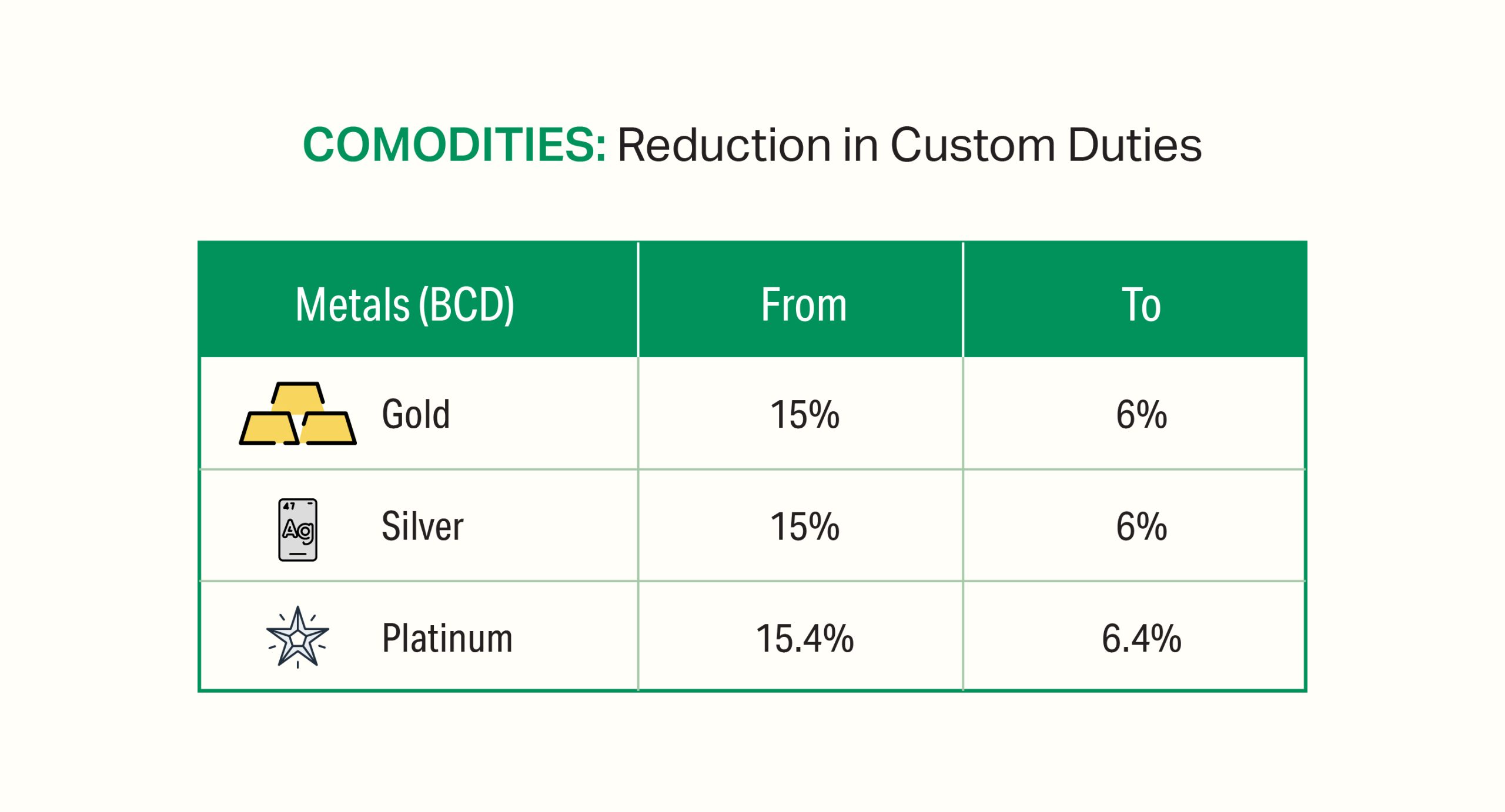
The recent significant duty cut is anticipated to benefit the domestic jewellery market by boosting demand, lowering prices, and encouraging increased investment in precious metals. By reducing smuggling and fostering a more competitive market, the government aims to create a conducive environment for jewellery businesses to thrive.
PART B
In 2022-23, over 58% of corporate tax revenue came from the simplified tax regime, and more than two-thirds of taxpayers have adopted the new personal income tax regime.
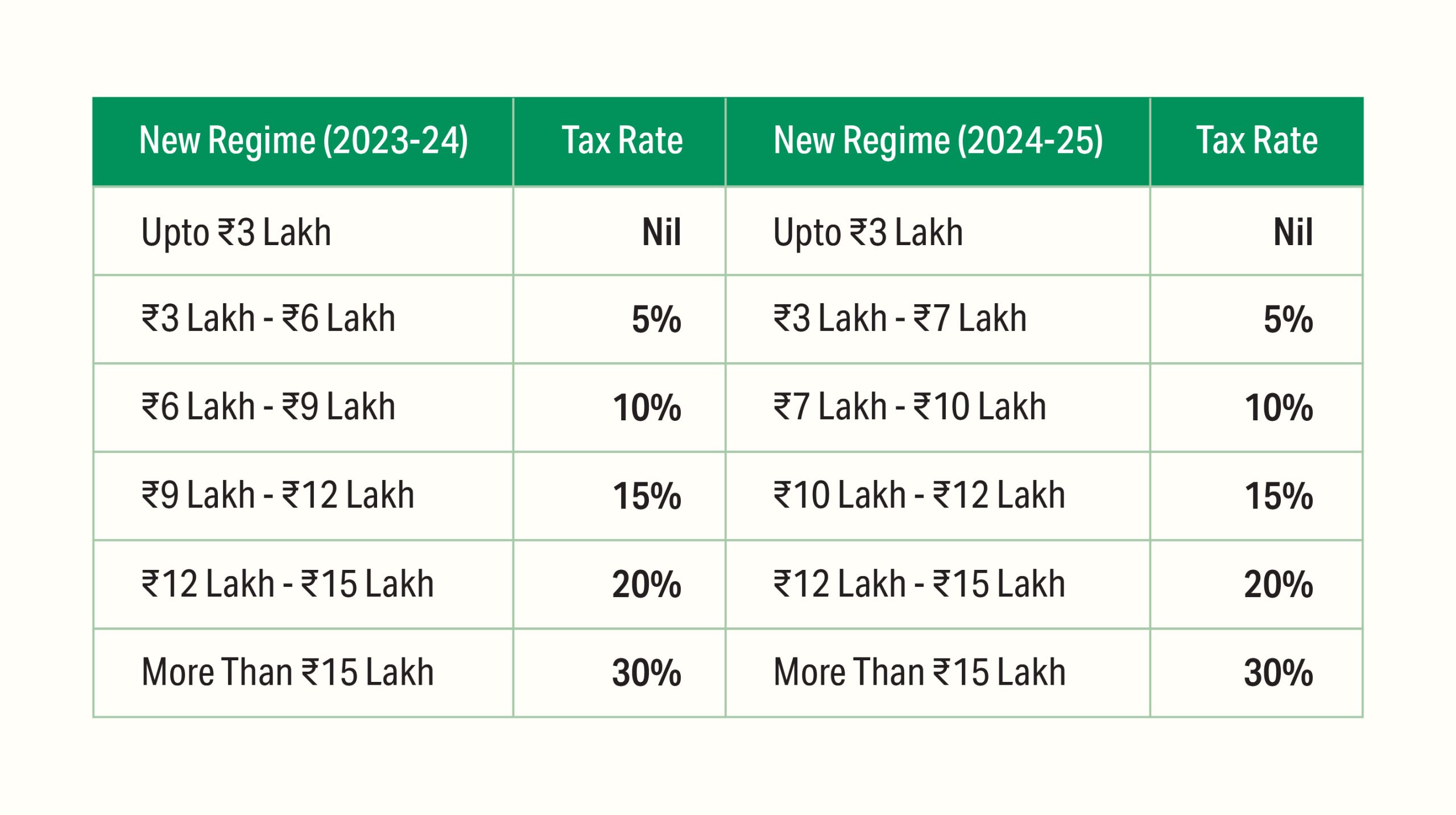
The revised tax slabs are expected to save salaried employees ~₹17,500, taking into account the standard deduction.
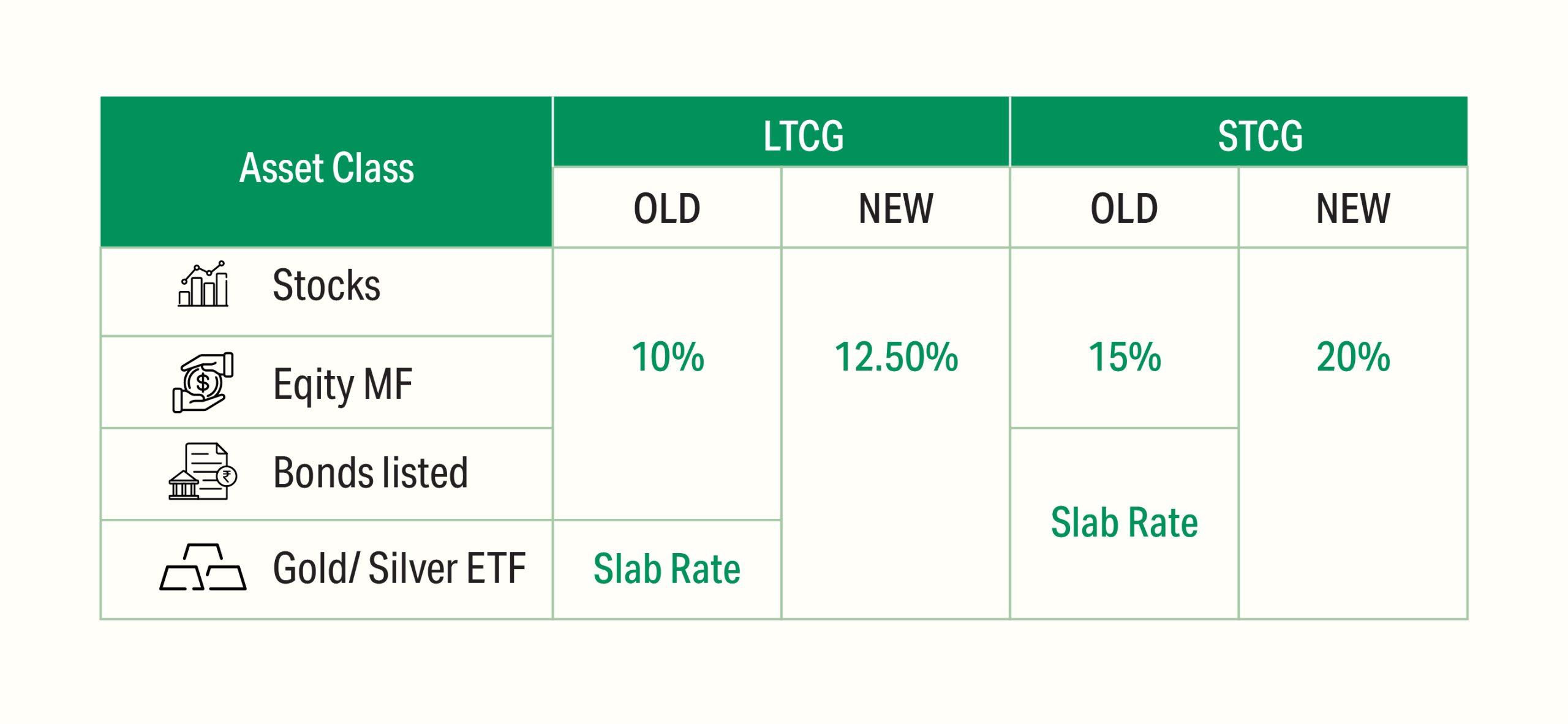
- The standard deduction for salaried employees is proposed to be increased from ₹50,000/- to ₹75,000/-.
- Similarly, the deduction on family pension for pensioners is proposed to be enhanced from ₹ 15,000/- to ₹ 25,000/-
- This will provide relief to about four crore salaried individuals and pensioners.
The finance minister has also removed the indexation benefits previously available for property sales and reduced the Long-Term Capital Gains (LTCG) tax on property from 20% to 12.5%. While this may impact short-term investments, it aims to simplify the computation of capital gains for both taxpayers and tax administration.
India's tax reforms reflect a commitment to creating a conducive environment for economic growth. India is attracting investments and encouraging industrial development by reducing corporate tax rates, particularly for new manufacturing units. The simplified personal income tax regime has reduced compliance burdens and has been well-received by taxpayers, indicating a positive shift towards a more efficient tax system.
In 2018, when the capital gains tax was introduced, adverse economic conditions occurred, and there were high corporate debts. Still, today's resilient economic environment and strong corporate balance sheets support our confidence that these policies will drive further growth.
In comparison to developed countries, India's tax rates are competitive, and its ongoing reforms are positioning it as an attractive destination for business and investment, signaling a robust trajectory toward development.
Disclaimers and Disclosures
SEBI Registration No. :INH000017338, IN/AIF3/24-25/1571, IN/AIF2/24-25/1607 | BASL Membership ID: 6276
Investment in Securities Market are subject to market risks. Read all related documents carefully before investing. The securities quoted are for illustration only and are not recommendatory. Registration granted by SEBI, membership of a SEBI recognized supervisory body (if any) and certification from NISM in no way guarantee performance of the intermediary or provide any assurance of returns to investors.


 Follow
Follow